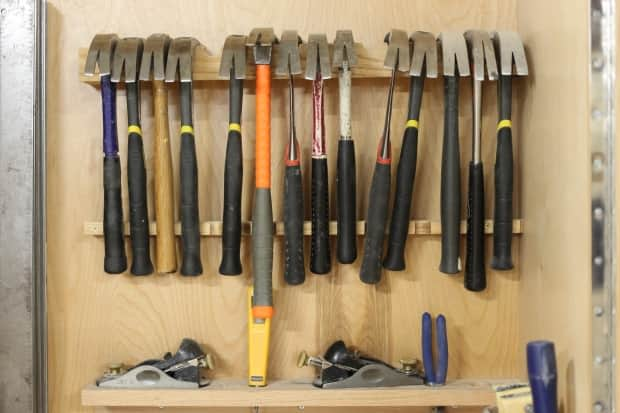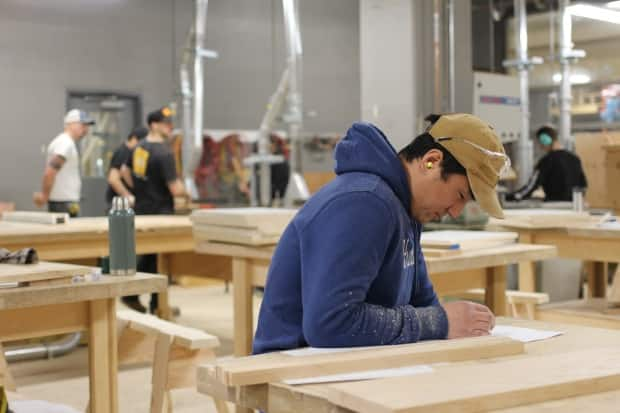Canada needs carpenters, electricians and other skilled trades — and enrolment for apprenticeships is surging

As a high school student strong in math and science, Amy Spiers took what seemed like the natural next step after graduation and earned a degree in geomatics engineering.
But after 12 years in the industry, Spiers craved something more creative and hands-on, which led her to an apprenticeship in carpentry.
"I've always loved building things," said Spiers, now 37 and in her third year at the Southern Alberta Institute of Technology (SAIT) in Calgary.

Spiers is part of a growing number of people in Canada signing up for apprenticeships amid ongoing labour shortages in many of the skilled trades.
After plummeting during the pandemic, the number of people registering for apprenticeships has now bounced back and is at its highest level since 2014, according to the latest available data from Statistics Canada.
In 2022, 81,141 Canadians registered in an apprenticeship program, an increase of roughly 12 per cent from 2021.
The growing interest in the trades is good news for industries such construction and manufacturing that have struggled in recent years to find skilled workers, though the uptick in registrations hasn't yet translated to a surge of certified tradespeople.
Growing demand
While all provinces and territories have seen an uptick in registrations, "it is Alberta, Quebec and Ontario that are leading this charge," said Graham Ziegler, who heads the Canadian Centre for Education Statistics at Statistics Canada.

The picture looks a little different in each province.
Quebec, for instance, saw most of its growth coming from enrolment in programs for carpenters and electricians, while Alberta saw most of its growth coming from apprentice electricians, plumbers, steamfitters, pipefitters and heavy-duty equipment mechanics.
The average employment income for a Red Seal Trade in Canada is $111,500, according to a recent report from the non-profit Canadian Apprenticeship Forum, though incomes vary significantly depending on the specific type of trade.
Industrial electricians, for example, earn around $182,200 a year, while hair stylists and barbers earn around $44,700, the report said.
The growing interest in various types of trades is playing out in the hallways and classrooms at SAIT, which is one of the country's largest post-secondary institutions for apprenticeship education.
SAIT has seen a nearly 20 per cent increase in its apprentices in the last two years, from 5,494 in the 2021/2022 school year to 6,541 so far this year.
Officials expect that interest will continue to grow, and are adding another 1,000 apprenticeship seats for the upcoming school year to meet the anticipated demand.
"It's a good thing," said Jim Szautner, SAIT's dean of apprenticeship.
"It was very well known that folks in the trades were aging and would age out and retire … so it's very refreshing to see that we are having new folks come in."
Aging workforce, rapid construction create opportunities
Certified tradespeople are indeed an aging sector of the workforce, said Ziegler of Statistics Canada. The number of tradespeople aged 55 or older grew between the last two census surveys in 2016 and 2021, while the number of youth tumbled, he said.
"All of this coincides with rising job vacancies for certified tradespeople, which nearly doubled from Q3 of 2019 to Q3 of 2023," he said.
"So certainly there are some challenges, but I think there's also an opportunity for those considering a career in the skilled trades."

The opportunity created by this demographic transition is part of what drew Eric Corbin to the trades.
Corbin, who is also enrolled in SAIT's carpentry program, had previously worked at a ski resort, but was frustrated by the amount of money he was making. He wanted a career with a long-term future.
"I knew that [we would] be losing a lot of older tradespeople, and now it's kind of the best time to learn from them and then hopefully take their jobs in the future," said Corbin, 33.
"I knew it was the best place to be."

Still, Kevin Lee, CEO of the Canadian Home Builders' Association, said the current uptick in people registering for apprenticeships won't be enough.
An existing labour shortage in that sector is expected to worsen in the decade ahead. Roughly 20 per cent of construction workers are expected to retire in the next 10 years, a period in which the federal government also aims to double the rate of housing construction.
"It's gonna take some time to build ourselves out of the current situation," said Lee, who believes targeted immigration to attract skilled workers also needs to be part of the solution.
Certifications still lagging
Another wrinkle is that while the number of Canadians registering for apprenticeships is growing, the number of people certifying in the trades still lags below pre-COVID levels.
That's partly due to the lingering impact of the pandemic, when closed job sites made it difficult for apprentices to complete their programs.
It's also reflective of a broader trend: the number of people who register for apprenticeships has historically been far higher than the number of people who end up becoming certified in the trades.
The average completion rate for men in the top 15 largest apprenticeship programs in Canada was 47 per cent in 2021, according to the Canadian Apprenticeship Forum. For women, it was 34 per cent.
For some people and some positions, that may not matter. For instance, Lee noted that someone can have a successful career in framing without necessarily becoming a certified carpenter.
For others, it does. In most provinces, for example, electricians must be certified in order to practice.
Emily Arrowsmith, director of research and programs with the Canadian Apprenticeship Forum, said certification often also translates into better pay and more opportunities for advancement. It's therefore something her organization tries to encourage as much as possible.
One way to help narrow the gap between registrations and certifications, she said, is to make the trades more inclusive. Women, for example, may enter apprenticeships but leave before they get certified if they feel isolated or unwelcome at their job sites, she said.
Arrowsmith said work underway by the United Brotherhood of Carpenters and the BC Centre for Women in the Trades is part of an industry-wide push to make the trades more welcoming — a move she believes will help the trades to both recruit and retain workers in the long-term.
Spiers, the carpentry apprentice, said she supports anything that can help people of different backgrounds understand each other and work together better.
A more pragmatic approach could also help, she said, pointing to a federal pilot project that offered women grants for completing their certification. The pilot ended last year.
"It would be nice to have that back," she said.


 Yahoo News
Yahoo News 
